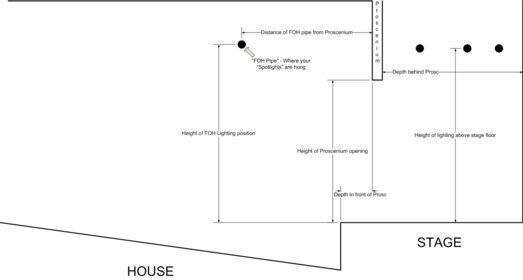So is it a
grid above the
stage, not a fly
system?
To start I would say you need many more instruments above the
stage. It is standard to be able to divide the
stage into 3 sections SL, CT, SR and also US and DS some people add a mid
stage brake into the mix. If you go with individual lights (not strips) it would be standard to use 2 instruments (a warm and a cool), some people like to do a 3 color
wash. For your purpose right now I would stick with 2. Even if you go with strips it is still standard to brake the
stage into SL, CT, SR and DS, US. When using strips it all depends on what type you get, how many lamps they have, and their physical measurements. How high are you electrics/
grip (depending)?
Far as front light goes it is also standard to split the
stage into SL, CT, SR, US and DS. With a warm and cool for each area.
To help clarify what I mean by these areas. Not to insult you by any means but just incase you don't know
SR=
Stage Right (standing on
stage looking at the audience)
CT=Center
Stage
SL=
Stage Left (standing on
stage looking at the audience)
US=
Up Stage (farthest away from the audience)
DS=
Down Stage (Closest to the audience)
Also it may take more than one
instrument to light each area fully. We have 2 warms and 2 cools spaced out to just get SL and this is mirrored SR with only 1 warm and 1 cool in the center. This a crude diagram
SR ---1 2----3 4----5 6----7 8----9 10--- SL
.........w c....w c.....w c ...w c.....w c
............................CT
So 1-4 make up SR 5&6 are CT and 7-10 are SL. To save dimmers we
two-fer the warms together SR and the Cools together SR and mirror that on SL but on separate dimmers.
With measurements we can even help you further, but you should also learn
photometrics. Its done with A^2+B^2=C^2. So lets say to find a
FOH throw distance. The
trim hight is 25' and then its 30' to the object/area you are lighting. Subtract 5' from your
trim height to factor in a person so 20^2 = 400. 30^2 =900. 200+900=1100. 1100 square root= 33, 33' is your
throw distance to the object you are lighting. From there you would look on a manufacturers specs for a specific light and times (X) 33' by a given number. For example if it was a 36*
ETC source four it is 33X.45=14'10" beam diameter, for the field diameter its 33X.63=20'9".
The beam diameter is where the light is 100% efficient and going from center of the light at 7'5" entering the field diameter is where the light out put drops to 50% efficiency and drops until there is no light left



